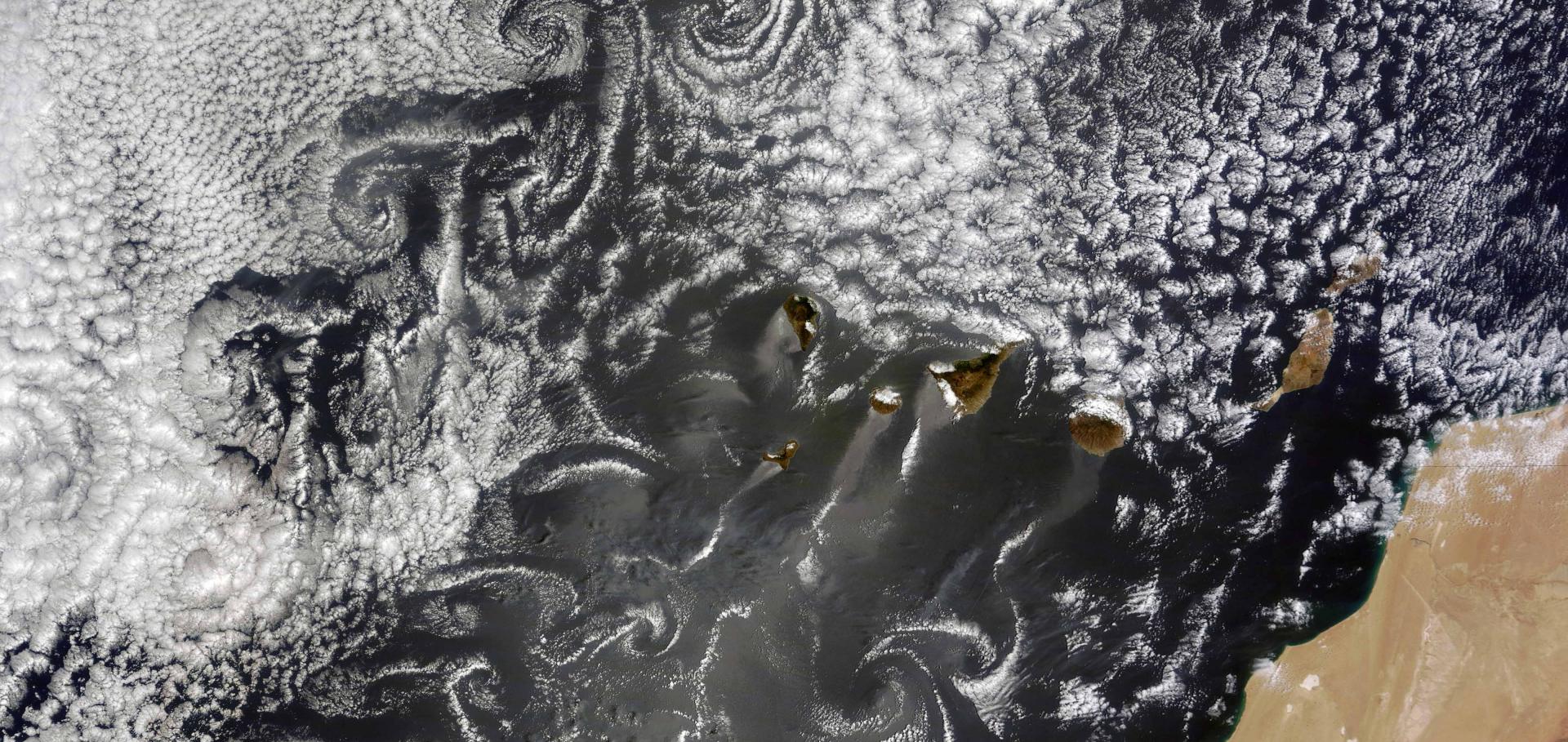A large-scale analysis of pockets of open cells and their radiative impact
Geophysical Research Letters American Geophysical Union 48:6 (2021) e2020GL092213
Abstract:
Pockets of open cells sometimes form within closed‐cell stratocumulus cloud decks but little is known about their statistical properties or prevalence. A convolutional neural network was used to detect occurrences of pockets of open cells (POCs). Trained on a small hand‐logged dataset and applied to 13 years of satellite imagery the neural network is able to classify 8,491 POCs. This extensive database allows the first robust analysis of the spatial and temporal prevalence of these phenomena, as well as a detailed analysis of their micro‐physical properties. We find a large (30%) increase in cloud effective radius inside POCs as compared to their surroundings and similarly large (20%) decrease in cloud fraction. This also allows their global radiative effect to be determined. Using simple radiative approximations we find that the instantaneous global annual mean top‐of‐atmosphere perturbation by all POCs is only 0.01 W/m2.An overview of the ORACLES (ObseRvations of Aerosols above CLouds and their intEractionS) project: aerosol-cloud-radiation interactions in the Southeast Atlantic basin
Atmospheric Chemistry and Physics Copernicus Publications 21:3 (2021) 1507-1563
Abstract:
Southern Africa produces almost a third of the Earth’s biomass burning (BB) aerosol particles, yet the fate of these particles and their influence on regional and global climate is poorly understood. ORACLES (ObseRvations of Aerosols above CLouds and their intEractionS) is a five-year NASA EVS-2 (Earth Venture Suborbital-2) investigation with three Intensive Observation Periods designed to study key atmospheric processes that determine the climate impacts of these aerosols. During the Southern Hemisphere winter and spring (June-October), aerosol particles reaching 3–5 km in altitude are transported westward over the South-East Atlantic, where they interact with one of the largest subtropical stratocumulus subtropical stratocumulus (Sc) cloud decks in the world. The representation of these interactions in climate models remains highly uncertain in part due to a scarcity of observational constraints on aerosol and cloud properties, and due to the parameterized treatment of physical processes. Three ORACLES deployments by the NASA P-3 aircraft in September 2016, August 2017 and October 2018 (totaling ~350 science flight hours), augmented by the deployment of the NASA ER-2 aircraft for remote sensing in September 2016 (totaling ~100 science flight hours), were intended to help fill this observational gap. ORACLES focuses on three fundamental science questions centered on the climate effects of African BB aerosols: (a) direct aerosol radiative effects; (b) effects of aerosol absorption on atmospheric circulation and clouds; (c) aerosol-cloud microphysical interactions. This paper summarizes the ORACLES science objectives, describes the project implementation, provides an overview of the flights and measurements in each deployment, and highlights the integrative modeling efforts from cloud to global scales to address science objectives. Significant new findings on the vertical structure of BB aerosol physical and chemical properties, chemical aging, cloud condensation nuclei, rain and precipitation statistics, and aerosol indirect effects are emphasized, but their detailed descriptions are the subject of separate publications. The main purpose of this paper is to familiarize the broader scientific community with the ORACLES project and the data set it produced.An overview of the ORACLES (ObseRvations of Aerosols above CLouds and their intEractionS) project: aerosol–cloud–radiation interactions in the southeast Atlantic basin
Atmospheric Chemistry and Physics Copernicus GmbH 21:3 (2021) 1507-1563
Abstract:
<jats:p>Abstract. Southern Africa produces almost a third of the Earth's biomass burning (BB) aerosol particles, yet the fate of these particles and their influence on regional and global climate is poorly understood. ORACLES (ObseRvations of Aerosols above CLouds and their intEractionS) is a 5-year NASA EVS-2 (Earth Venture Suborbital-2) investigation with three intensive observation periods designed to study key atmospheric processes that determine the climate impacts of these aerosols. During the Southern Hemisphere winter and spring (June–October), aerosol particles reaching 3–5 km in altitude are transported westward over the southeast Atlantic, where they interact with one of the largest subtropical stratocumulus (Sc) cloud decks in the world. The representation of these interactions in climate models remains highly uncertain in part due to a scarcity of observational constraints on aerosol and cloud properties, as well as due to the parameterized treatment of physical processes. Three ORACLES deployments by the NASA P-3 aircraft in September 2016, August 2017, and October 2018 (totaling ∼350 science flight hours), augmented by the deployment of the NASA ER-2 aircraft for remote sensing in September 2016 (totaling ∼100 science flight hours), were intended to help fill this observational gap. ORACLES focuses on three fundamental science themes centered on the climate effects of African BB aerosols: (a) direct aerosol radiative effects, (b) effects of aerosol absorption on atmospheric circulation and clouds, and (c) aerosol–cloud microphysical interactions. This paper summarizes the ORACLES science objectives, describes the project implementation, provides an overview of the flights and measurements in each deployment, and highlights the integrative modeling efforts from cloud to global scales to address science objectives. Significant new findings on the vertical structure of BB aerosol physical and chemical properties, chemical aging, cloud condensation nuclei, rain and precipitation statistics, and aerosol indirect effects are emphasized, but their detailed descriptions are the subject of separate publications. The main purpose of this paper is to familiarize the broader scientific community with the ORACLES project and the dataset it produced. </jats:p>The CLoud–Aerosol–Radiation Interaction and Forcing: Year 2017 (CLARIFY-2017) measurement campaign
Atmospheric Chemistry and Physics Copernicus Publications 21:2 (2021) 1049-1084
Abstract:
The representations of clouds, aerosols, and cloud–aerosol–radiation impacts remain some of the largest uncertainties in climate change, limiting our ability to accurately reconstruct past climate and predict future climate. The south-east Atlantic is a region where high atmospheric aerosol loadings and semi-permanent stratocumulus clouds are co-located, providing an optimum region for studying the full range of aerosol–radiation and aerosol–cloud interactions and their perturbations of the Earth's radiation budget. While satellite measurements have provided some useful insights into aerosol–radiation and aerosol–cloud interactions over the region, these observations do not have the spatial and temporal resolution, nor the required level of precision to allow for a process-level assessment. Detailed measurements from high spatial and temporal resolution airborne atmospheric measurements in the region are very sparse, limiting their use in assessing the performance of aerosol modelling in numerical weather prediction and climate models. CLARIFY-2017 was a major consortium programme consisting of five principal UK universities with project partners from the UK Met Office and European- and USA-based universities and research centres involved in the complementary ORACLES, LASIC, and AEROCLO-sA projects. The aims of CLARIFY-2017 were fourfold: (1) to improve the representation and reduce uncertainty in model estimates of the direct, semi-direct, and indirect radiative effect of absorbing biomass burning aerosols; (2) to improve our knowledge and representation of the processes determining stratocumulus cloud microphysical and radiative properties and their transition to cumulus regimes; (3) to challenge, validate, and improve satellite retrievals of cloud and aerosol properties and their radiative impacts; (4) to improve the impacts of aerosols in weather and climate numerical models. This paper describes the modelling and measurement strategies central to the CLARIFY-2017 deployment of the FAAM BAe146 instrumented aircraft campaign, summarizes the flight objectives and flight patterns, and highlights some key results from our initial analyses.Isolating large-scale smoke impacts on cloud and precipitation processes over the Amazon with convection permitting resolution
Wiley (2021)


